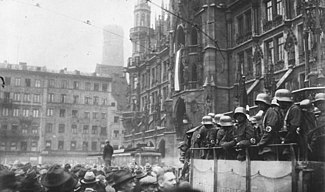
Back Hitlerputsch ALS Putsch de Múnich AN انقلاب بير هول Arabic انقلاب بير هول ARZ Putsch de Múnich AST Pivə qiyamı Azerbaijani مونیخ کودتاسی AZB Піўны путч Byelorussian Піўны путч BE-X-OLD Бирен пуч Bulgarian
| Munich Putsch Beer Hall Putsch | |||||||||
|---|---|---|---|---|---|---|---|---|---|
| Part of Political violence in Germany (1918–1933) | |||||||||
 Nazis at the Marienplatz in Munich during the Putsch | |||||||||
| |||||||||
| Belligerents | |||||||||
| Commanders and leaders | |||||||||
|
| |||||||||
| Military support | |||||||||
| 2,000+ | 130 | ||||||||
| Casualties and losses | |||||||||
|
15 killed About a dozen injured Many captured and imprisoned |
4 killed Several wounded | ||||||||
| 1 civilian killed | |||||||||
The Beer Hall Putsch, also known as the Munich Putsch,[1][note 1] was a failed coup d'état by Nazi Party (Nationalsozialistische Deutsche Arbeiterpartei or NSDAP) leader Adolf Hitler, Generalquartiermeister Erich Ludendorff and other Kampfbund leaders in Munich, Bavaria, on 8–9 November 1923, during the Weimar Republic. Approximately two thousand Nazis marched on the Feldherrnhalle, in the city centre, but were confronted by a police cordon, which resulted in the deaths of 15 Nazis, four police officers, and one bystander.[2][3]
Hitler escaped immediate arrest and was spirited off to safety in the countryside. After two days, he was arrested and charged with treason.[4]
The putsch brought Hitler to the attention of the German nation for the first time and generated front-page headlines in newspapers around the world. His arrest was followed by a 24-day trial, which was widely publicised and gave him a platform to express his nationalist sentiments. Hitler was found guilty of treason and sentenced to five years in Landsberg Prison,[note 2] where he dictated Mein Kampf to fellow prisoners Emil Maurice and Rudolf Hess. On 20 December 1924, having served only nine months, Hitler was released.[5][6] Once released, Hitler redirected his focus towards obtaining power through legal means rather than by revolution or force, and accordingly changed his tactics, further developing Nazi propaganda.[7]
- ^ Dan Moorhouse, ed. The Munich Putsch. Archived 5 January 2017 at the Wayback Machine schoolshistory.org.uk, accessed 2008-05-31.
- ^ Shirer 1960, pp. 73–75.
- ^ "Einsatz für Freiheit und Demokratie". 11 June 2015. Archived from the original on 11 June 2015. Retrieved 25 October 2023.
- ^ Hitler, Adolf (1924). Der Hitler-Prozeß vor dem Volksgericht in München [The Hitler Trial Before the People's Court in Munich]. Munich: Knorr & Hirth. OCLC 638670803.
- ^ Harold J. Gordon Jr., The Hitler Trial Before the People's Court in Munich (Arlington, VA: University Publications of America 1976)
- ^ Fulda, Bernhard (2009). Press and politics in the Weimar Republic. Oxford University Press. pp. 68–69. ISBN 978-0-19-954778-4.
- ^ Claudia Koonz, The Nazi Conscience, p. 24, ISBN 0-674-01172-4.
Cite error: There are <ref group=note> tags on this page, but the references will not show without a {{reflist|group=note}} template (see the help page).
© MMXXIII Rich X Search. We shall prevail. All rights reserved. Rich X Search